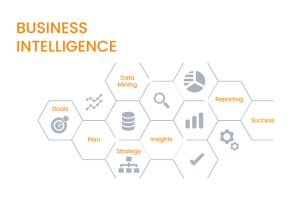Business intelligence
Business intelligence comprises the strategies and technologies used by enterprises for the data analysis of business information. BI technologies provide historical, current, and predictive views of business operations.
 • What is Business Intelligence?
• What is Business Intelligence?
In general, a BI (Business Intelligence) solution is a combination of strategy and technology for gathering, analyzing, and interpreting data from internal and external sources, with the end result of providing information and analytics about the past, present, and future state of the subject being examined.
BI or business analytics solutions offer applications to help you gain actionable information at every stage of the process. This includes applications for data preparation, analysis, data visualization, reporting, and collaboration for use on premises, at the desktop, in the cloud, and away from the office via mobile capability.
Individual ERP applications can offer software as a service (SaaS), while a complete suite of ERP applications forms an ERP system that can be used to effectively communicate and bring together business processes to enable a flow of data between the applications, typically through common databases either on-site/on-premise or in the cloud.
ERPs connect every aspect of an enterprise. An ERP software system allows for better performance and project management that helps plan, budget, predict and accurately report on an organization’s financial health and processes.
Gain comprehensive business intelligence with augmented analytics to help your organization grow through unique insights. Oracle Analytics uses embedded machine learning and artificial intelligence to analyze data from across your organization so you can make smarter predictions and better decisions.

• Business intelligence benefits
Data, It’s big, It’s getting bigger, and it’s growing exponentially, More and more people produce it. Data is created by an increasing number of things—commonly called devices. It’s becoming more varied and more unstructured. About five years ago, someone said 90 percent of the world’s data was generated by the previous two years. That’s astonishing.
Data and the ability to derive insights from that data is the most valuable resource for sustaining and growing businesses.
Using a best-in-class approach to BI can help your organization gain a competitive advantage by reducing the time and effort required to acquire, integrate, distribute, review, and respond to new data.
The better organizations are at processing data, the more benefits they gain from BI. Those data-processing leaders are exerting immense pressure on all competitors who fail to recognize the potential in-time data. Late adopters are forced to speed up their analytics ambitions to stay on par with competitors and new market entrants.
BI represents the heart of every data-driven enterprise, which makes it the epicenter of transformation. Increasing the impact of an organization and making it more efficient are the ultimate goals of implementing a new BI tool; however, with the right BI technology, you can derive several additional benefits as well.
- Improve data accuracy
- Make better decisions more quickly
- Improve mission-critical outcomes
- Share data across business functional areas
- Gain better visibility into financial and operational information
- Identify and reduce inefficiencies
- Eliminate waste, fraud, and abuse
- Improve productivity and worker morale
- Boost return on investment, while cutting total cost of ownership
- Enhance transparency and service at all levels
• How business intelligence solutions make the most of your data

BI solutions have the potential to be an essential tool for decision-making and strategy development. The resulting information can be used throughout a company, from marketing and sales to supply chain and finance, for tasks such as :
- Measuring marketing campaign results
- Gaining visibility into cash flow, gross margins, and operating expenses
- Capturing insights about employees and prospects to optimize HR processes and recruitment
- Tracking parts and material trends and supplier performance
- Forecasting revenues and transactions
- Optimizing call center and depot staffing levels
- Obtaining cross-enterprise views
- Uncovering new revenue opportunities and patterns
BI can help everyone in your organization, But to do that, it needs to be a special kind of solution.
The average enterprise solution requires an IT department to set up the environment and, in many cases, connect the internal and external data sources. Historically, IT was responsible for all BI, because these solutions usually required specialized expertise such as an in-depth knowledge of SQL or extensive scripting for data preparation.
• What you should look for in a business intelligence solution
To make BI an effective solution for business units—or for anyone else with a relatively low level of technical knowledge—the solution has to be as user friendly and accessible as possible for all levels of employees throughout an organization.
Consider a solution that offers a single, integrated platform of applications. Many organizations have a legacy business intelligence ecosystem featuring multiple solutions for reporting, discovery, analysis, and other functions. Working with all those solutions can be expensive and require extensive technical knowledge. Multiple solutions can also create compatibility issues.
A single-platform approach offers an end-to-end solution that includes gathering, analyzing, and interpreting data, with everything working together so there are no compatibility issues. With everything in one place, there’s no need to go hunting for tools. You can centralize your data models and metrics for a comprehensive representation of your business—something that can be difficult to accomplish with a multiple-solution ecosystem.
A BI solution should be easy for users across your enterprise to access—whether they are in the office, working remotely, or on the road. A cloud solution offers the highest potential for accessibility and availability. It can be accessed when and where it’s needed, for individual use or shared with coworkers.
A cloud solution also can be easily scaled to fit an organization of almost any size and is flexible enough to meet the demands of a growing business.
Most BI solutions have the capability to connect with one or more data sources. Consider a solution that offers prebuilt connections. With this type of solution, it’s easy to load and integrate data from diverse sources. Prebuilt connections eliminate the time needed to make the connections and reduce the complexity of the solution, enabling your IT people to focus on other tasks.
You want a smart solution that can make BI easy—one with augmented analytics employing embedded machine learning. This kind of solution can help users in gathering, analyzing, interpreting, and conveying information—simplifying and automating tasks.
Your solution should be able to automate data preparation and the collection and consolidation of information from multiple sources, accelerating the process and reducing the chance of errors. It should also be able to augment your analysis by recommending new data sets to include in the review for more accurate results.
You want a smart solution that lets you quickly and easily search for what you need and get to the data directly—one that allows you ask questions and receive answers in human language rather than code.
Some solutions even offer a semantic layer that allows users to access data and modify requests and data set parameters via common business terms.
Users should also be able to easily access predictive analytics and forecasting to see patterns and forecast future outcomes and trends—without the need-to-know coding. A smart solution with embedded machine learning can offer that advantage and more.
Many smart solutions come with data visualization, which provides the capability to automatically transform data into pie charts, graphs, or other types of visual presentation. Users can quickly and easily see and understand patterns, relationships, and emerging trends that might go unnoticed in a spreadsheet of raw numbers.
With data visualization, you can get new and unique insights by creating rich data mashups. You also can craft stories about your business by using high-impact visuals that require no specialized training to interpret.
With this kind of smart system, you can pull data from internal and external sources. Then you can decide among numerous options which graphic is best for presenting the data, or you can allow the application to automatically make a recommendation based on data results.
To be a true business tool, a BI solution must be designed for businesspeople to use on their own—a self-service solution.
Your BI solution should be easy to navigate with point-and-click or drag-and-drop features. It should have some type of dashboard with intuitive, interactive access to information and offer guided, step-by-step navigation and built-in functionality so that customization is not required. It should give users a choice of doing a task themselves or employing automation to handle it.
Users also should have full control to load their data and analyze it from any angle to uncover issues and new opportunities. They should be able to mash up and blend internal and external data for deeper insights. When it comes to sharing what they’ve learned, users should be able to create their own reports.
They also should be able to discover the answers to their most pressing business questions and communicate their findings to their peers and management teams across the enterprise—without waiting for a response from IT.
In today’s accelerated world, businesspeople need access to intelligence around the clock, no matter where they are. So, consider a BI solution with mobile capabilities.
Mobile BI solutions are available with voice-enabled access and real-time alerts. You can talk to your data via a search-driven approach. You can view, analyze, and act on data in the cloud or on premises. You can create mobile analytical apps with rich, interactive visualization without writing a single line of code. You can build apps once and distribute anywhere—all from your phone or tablet.
A solution that incorporates AI and machine learning can provide you with a personalized assistant that understands what you need—when and where you need it. For example, say you have a business meeting in New York. The personalized assistant can determine what business report and graphics are required for your business meeting. It can translate speech to text and alert you when new data is available to analyze.
You won’t have stay tethered to your desk to analyze information. With a mobile device and a cloud-based BI solution, your analytics can come to you, wherever you are.

• Making the intelligent choice
Every organization needs BI. But to make sure that everyone in your organization has access to your data whenever and wherever they need it, you’ll want to choose a smart, easy-to-use, feature-rich BI solution so you can stay in the know by getting the most out of your data.



